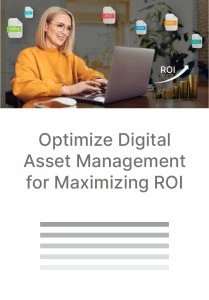Maximizing B2C and B2B Business ROI with Digital Asset Management


Get The Print Version
Download a PDF version for easier offline reading and sharing with coworkers
Digital asset management (DAM) plays a vital role in eCommerce by enabling efficient control and utilization of digital assets. As the eCommerce market expands, businesses increasingly rely on DAM systems to effectively organize and leverage their digital resources to ensure higher returns on investment.
According to recent research, the global Digital Asset Management (DAM) market is anticipated to experience a significant growth rate of 13% by 2028.
Therefore, the implementation of DAM in business is crucial. It empowers enterprises to enhance customer experiences and drive business growth by streamlining asset storage, retrieval, and distribution.
DAM enables centralized storage, organization, and accessibility of product images, videos, and marketing materials, ensuring brand consistency across multiple channels. It streamlines workflows, enhances collaboration among teams, and expedites time-to-market.
Additionally, this system is excellent for providing advanced analytics and reporting capabilities, enabling data-driven decision-making, and optimizing asset performance. By harnessing the power of DAM, eCommerce businesses can increase operational efficiency and ultimately drive revenue growth in this ever-evolving digital marketplace.
The Return on Investment (ROI) in eCommerce is an essential measure of the value and effectiveness of online retail. Therefore, measuring the ROI with DAM is necessary, as this system control organizations’ digital assets, like product images and marketing materials. That emphasizes the benefits of efficiency, streamlined workflows, consistent branding, and better customer experiences.
Using DAM technologies, eCommerce businesses can improve their asset management processes, save money, increase conversions, and enhance business performance. This blog will focus on how eCommerce businesses can improve their ROI using DAM systems and the calculation process.
The Impact of DAM on ROI
Digital Asset Management (DAM) significantly impacts Return on Investment (ROI) by delivering numerous benefits and optimizing various aspects of business operations. Let’s discuss how it influences the business ROI:
Empower Efficiency
DAM systems provide a centralized repository for digital assets, enabling efficient organization, searchability, and retrieval. This streamlines workflows reduces time spent on asset management tasks, and allows employees to focus on revenue-generating activities. The time saved translates into increased productivity and ultimately enhances ROI.
Elevate Brand Consistency
This system ensures brand consistency by storing all the eCommerce up-to-date assets. This consistency strengthens brand identity, enhances brand recognition, and fosters customer trust.
It allows the business to ensure a consistent brand image across marketing materials, product images, and videos, leading to improved customer experiences, higher engagement, and increased conversion rates, all of which positively impact ROI.
Cost Effectiveness
DAM eliminates the need for redundant asset creation and storage. It reduces costs associated with recreating assets, purchasing external assets, or facing copyright infringements.
Businesses can achieve significant cost savings by optimizing asset usage and minimizing unnecessary expenses, directly enhancing the ROI.
Accelerate Collaboration
This system facilitates seamless collaboration and version control among team members. It enables real-time asset sharing, feedback exchange, and simultaneous work, enhancing efficiency and faster time-to-market.
The streamlined collaboration and increased operational efficiency directly impact ROI, as projects are completed more quickly, sales cycles are shortened, and revenue is generated faster.
Data-Driven Decision-Making
DAM systems often offer analytics and reporting features that provide insights into asset performance, usage patterns, and audience engagement. By leveraging these analytics, businesses can make data-driven decisions, optimize asset utilization, and align their strategies to drive higher ROI.
DAM positively impacts ROI by streamlining workflows, enhancing brand consistency, reducing costs, improving collaboration and efficiency, and enabling data-driven decision-making.
By investing in a DAM system and harnessing its capabilities, businesses can unlock more excellent value from their digital assets, improving financial performance and long-term profitability.
Unlocking eCommerce Success with DAM ROI

Digital asset management (DAM) is crucial in driving ROI in eCommerce. In the competitive online retail industry, effectively managing digital assets is essential for generating revenue and ensuring business success.
This system helps eCommerce businesses organize and store digital assets, such as images and videos, in a centralized location. It allows for easier retrieval and improved productivity. By saving time and expanding efficiency, companies can lower costs and focus more on generating revenue.
DAM in eCommerce can lead to a positive return on investment by enhancing the customer experience. Businesses can influence buyers’ purchase decisions by using high-quality images and videos. This system allows companies to maintain consistent branding, accurate product representation, and swift loading times on different platforms.
It eventually results in higher conversion rates, increased order values, and customer loyalty, leading to a positive ROI. Further, DAM can improve the return on investment for eCommerce by enriching customer-facing assets and enhancing internal support management. It includes employee training materials, sales presentations, and brand guidelines.
DAM also promotes collaboration and knowledge sharing among teams, increasing productivity, cutdown errors, and ensuring better business results. Moreover, DAM’s measurement and analysis of eCommerce ROI offer valuable insights into asset utilization effectiveness.
Besides, eCommerce companies can easily track asset downloads, usage patterns, and engagement levels to identify the best-performing assets, optimize content strategies, and make data-driven decisions. This continuous process of improvement and optimization enables businesses to allocate resources efficiently, leading to a higher return on investment.
How to Calculate DAM ROI

Calculating ROI For DAM involves measuring the financial benefits of implementing this system compared to the costs incurred. Here’s a step-by-step guide to calculating DAM ROI:
Identify Costs
Start by identifying all the costs of implementing and maintaining the DAM system. It includes software licenses, hardware infrastructure, implementation and customization fees, training, and ongoing maintenance expenses. Be sure to consider both upfront and recurring costs.
Determine Benefits
Identify the key areas where the DAM system is expected to provide benefits. It can include time savings, increased productivity, reduced asset search time, improved collaboration, enhanced customer experience, and cost savings through streamlined workflows.
Assign Monetary Value
Convert the quantified benefits into monetary terms. For example, if the DAM system saves employees an average of 10 hours per week, calculate the labor cost savings based on the hourly rate. If improved asset utilization leads to increased revenue, estimate the additional revenue generated by multiplying it with the average order value or conversion rate.
Calculate DAM ROI
Once you have the total costs and monetary value of the benefits, use the following formula to calculate DAM ROI:
DAM ROI = (Total Monetary Value of Benefits – Total Costs) / Total Costs * 100
This formula provides the ROI percentage, which indicates the return on investment as a percentage of the total costs incurred.
Evaluate and Monitor
Assess the calculated ROI percentage and compare it to the organization’s expectations and industry benchmarks. Additionally, establish a process for ongoing monitoring of DAM performance and continue to track and evaluate the benefits realized over time.
It’s important to note that ROI calculations may vary depending on the specific goals and metrics relevant to your business. The key is accurately identifying and quantifying costs and benefits to understand the ROI achieved through DAM implementation.
By following these steps and regularly reassessing DAM ROI, businesses can make informed decisions, optimize their DAM strategies, and continually improve their return on investment in digital asset management.
Embracing the Future of DAM
The future of DAM is poised to be shaped by advanced technologies that will drive maximum return on investment (ROI). According to Statista, “the Digital Assets market is projected to have around 994.30 million users by the year 2027.” Therefore, it’s essential to understand the potential advancement of DAM; let’s discuss a few of them below.
Use of AI and ML
AI and ML technologies will revolutionize DAM by enabling automated tagging, content recognition, and predictive analytics. A recent study found that an “AI-powered DAM system helps reduce an organization’s time spent on managing digital assets by 40%”. Therefore, choosing this technology will help enhance business ROI by cutting down time and cost.
For example, AI algorithms can analyze product images and automatically generate relevant tags, improving searchability and asset discoverability for eCommerce businesses. ML algorithms can analyze customer behavior patterns to provide personalized recommendations, enhancing the customer experience and driving higher conversions, resulting in maximum ROI.
Voice Empowering Conversations
Voice recognition and NLP technologies will simplify asset search and retrieval processes. Integrating voice assistants and chatbots with DAM platforms will enable users to search for assets using natural language queries.
For example, a retailer can have a voice-enabled DAM system that allows users to find specific product images or videos by speaking commands or describing the assets in natural language.
AR and VR Implementation
AR and VR technologies will transform how eCommerce businesses showcase their products. DAM platforms integrated with AR and VR capabilities will allow customers to visualize products in a virtual environment, enhancing the shopping experience.
For instance, a furniture retailer can use AR to let customers virtually place furniture items in their own space before making a purchase decision, increasing customer confidence and reducing product returns.
Blockchain Technology
Blockchain technology can bring transparency and security to digital asset management. By leveraging blockchain, eCommerce businesses can ensure the authenticity and ownership of their digital assets, reducing the risk of intellectual property infringement.
For example, a luxury fashion brand can use blockchain to track the entire lifecycle of its digital assets, from creation to distribution, providing proof of authenticity and protecting its brand integrity.
Cloud Computing and Scalability
Cloud-based DAM solutions will continue to dominate the market, providing scalability, flexibility, and cost-effectiveness. These platforms can handle the increasing volume and variety of digital assets in eCommerce businesses.
For instance, an online marketplace with thousands of sellers can leverage a cloud-based DAM solution to store, manage, and distribute a vast array of product images and videos to ensure a seamless shopping experience for customers.
Integration with Ecosystems and APIs
Integration with ecosystems and APIs will benefit eCommerce businesses using DAM systems significantly. For example, seamless integration with e-commerce platforms like Shopify or Magento allows for efficient product image management, ensuring consistent and high-quality visuals across all sales channels.
These integrations enhance workflow automation, content syndication, and digital marketing efforts, leading to broader reach, improved customer experiences, and ultimately driving higher ROI for eCommerce businesses.
Final Word
Digital asset management (DAM) drives business ROI in today’s digital landscape. By streamlining workflow processes, improving content reusability, enhancing searchability and accessibility, and enabling effective rights management, DAM systems can significantly impact the bottom line.
It benefits from managing metadata and tagging, version control, permissions, access control, analytics and reporting, and integration with existing tools, providing businesses with the tools they need to optimize their asset management strategies.
Organizations should customize their DAM software to maximize ROI, leveraging advanced features and integrations to align with their requirements. Embracing digital asset management is a strategic decision that can lead to increased efficiency, improved brand consistency, reduced costs, and higher returns on investment.
It enables eCommerce businesses to manage their digital assets, such as product images, videos, marketing materials, etc. By centralizing storage, organizing assets, and ensuring consistent branding, DAM enhances the customer experience, increases conversions, and drives revenue growth.
DAM also brings efficiency to eCommerce operations by streamlining collaboration, improving productivity, and accelerating time-to-market. It reduces redundant asset creation, saves costs on recreating assets, and minimizes copyright infringements.
Furthermore, DAM’s analytical capabilities provide valuable insights into asset performance, usage patterns, and audience engagement. By leveraging this data, businesses can make data-driven decisions, optimize asset utilization, and align their strategies to drive higher ROI.
The use of DAM in eCommerce is predicted to increase and will have a significant impact on ROI. It is vital to select the appropriate specialist to maximize its advantages. Businesses can effectively utilize their digital assets by implementing a tailored DAM system and offering personalized experiences according to customer requirements.
It will result in outstanding customer experiences, sustainable growth, and a competitive edge in eCommerce. Harness the potential of digital asset management and ensure the highest possible ROI.





